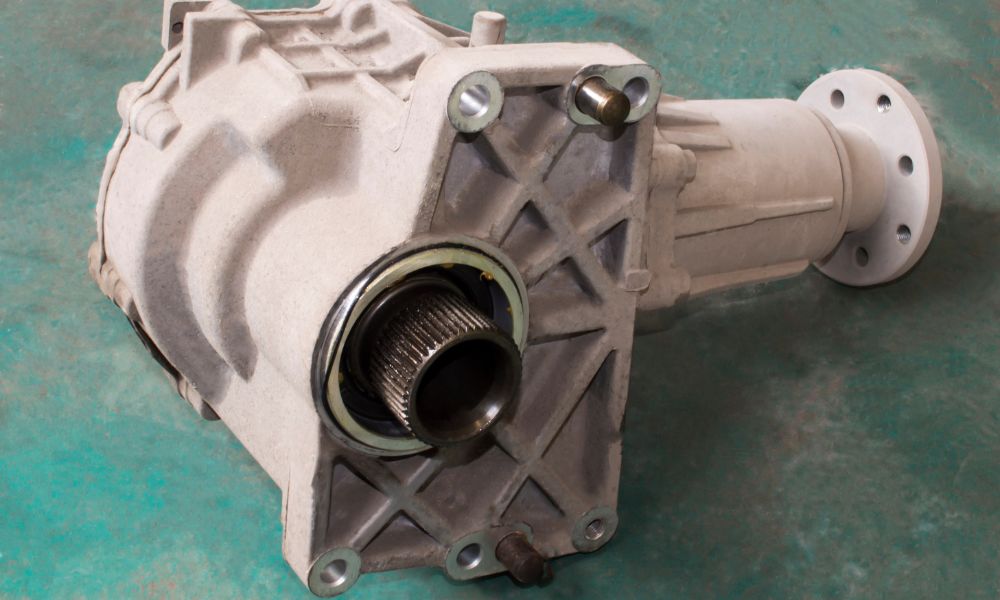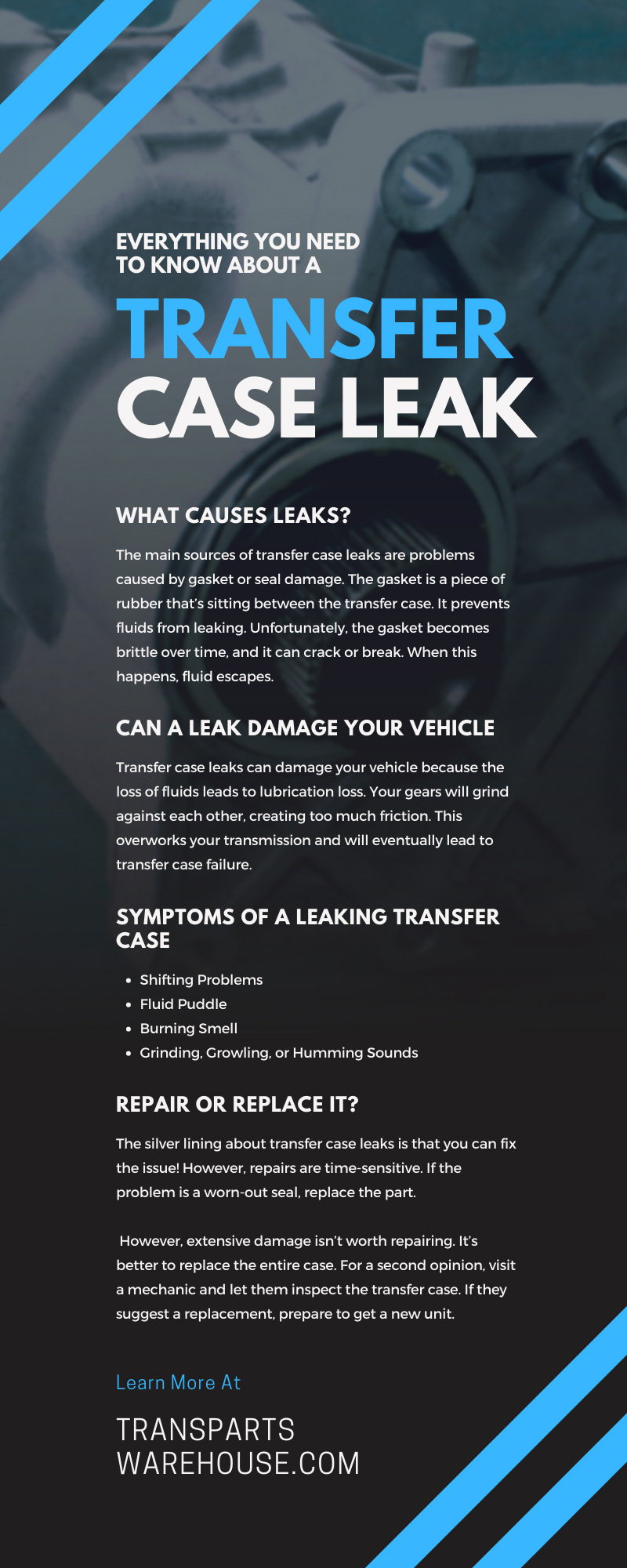
This guide has everything you need to know about a transfer case leak. Don’t let vehicle problems persist or turn into irreversible damage. Mitigate a leak and understand how to avoid future issues.
What Is a Transfer Case?
A transfer case is a mechanical part that’s attached to two-wheel and four-wheel-drive vehicle engines. It receives power from the transmission and sends it to the front and rear axles. The transfer case has two sets of gears.
The first set connects to the engine, and the second one connects to the axles. Both sets are vital components to vehicles as they help cars shift gears. Transfer cases and transmission work together to control power within the vehicle.
Given the importance of transfer cases, when leaks and damage occur, they can create an unsatisfactory (and unsafe) driving experience.
What Causes Leaks?
The main sources of transfer case leaks are problems caused by gasket or seal damage. The gasket is a piece of rubber that’s sitting between the transfer case. It prevents fluids from leaking. Unfortunately, the gasket becomes brittle over time, and it can crack or break. When this happens, fluid escapes.
Your vehicle’s seal is where the shaft connects to the transfer case. It prevents fluids from leaking out of the shaft. Like the gasket, seals become brittle over time too. When damage occurs, fluid escapes your vehicle.
Although these are two common sources of trouble, other things contribute to leaks as well. For example, transfer case damage makes the unit susceptible to leaks. Furthermore, the age, fluid, and condition of the transfer case contribute to the unit’s health.
Here are some other causes of leaks:
- Corrosion on shaft or cogs
- Bad electrical control unit
- Poor fluid
- Old shaft linkage
Can a Leak Damage Your Vehicle
Transfer case leaks can damage your vehicle because the loss of fluids leads to lubrication loss. Your gears will grind against each other, creating too much friction. This overworks your transmission and will eventually lead to transfer case failure.
Another thing to think about is dirt and water exposure. The leak allows contaminants to enter your system, which may damage gears and other vehicle parts.
If you have a bad or leaking transfer case, seek repairs as soon as possible. It’s not advisable to drive with a leaking transfer case because you make the damage worse. A repair job can turn into a full replacement if you don’t visit a mechanic.
Symptoms of a Leaking Transfer Case
Discovering a leaking transfer case isn’t an ideal situation for any driver. However, some indicators warn you about vehicle problems. Check out these symptoms of a leaking transfer case:
Shifting Problems
A common symptom of a leaking transfer case is having problems shifting between gears. This issue indicates low fluid levels or damaged linkage (which also causes leaks). Please note that shifting issues can also mean internal transfer case failure.
Fluid Puddle
Unfortunately, the only time you’ll see fluid under the transfer case area is when there is a leak. A transfer case leak has a light brown to reddish color. To confirm this leak, use a jack to lift your car and then inspect the area. Transfer case leaks are visible at the rear of your transmission.
Burning Smell
Losing lubrication is bad for vehicles. Transfer case fluids help things run smoothly. Without the right fluid levels, gears grind against each other. This releases a “burning metal” smell that’s unpleasant and concerning. Never ignore odd smells from your vehicle, especially a burning odor. Take your vehicle to a professional ASAP to get the issue looked at.
Grinding, Growling, or Humming Sounds
It’s never a good sign if strange noises are coming from your vehicle. The presence of an unusual sound is more than bothersome, and it usually indicates a bigger issue. In this situation, grinding, growling, or humming sounds may be coming from the transfer case. These various sounds could indicate low fluid levels.
Repair or Replace It?
The silver lining about transfer case leaks is that you can fix the issue! However, repairs are time-sensitive. If the problem is a worn-out seal, replace the part.
To replace the front output seal, take out the driveshaft and then unscrew the plate that holds the seal in place. Next, get rid of the old seal and install the new one. Use a sealant to secure everything in place!
Next, it’s time to replace the rear output seal. For this part, remove the driveshaft and then unscrew the transfer case from the back of the transmission. When it’s loose, pull it forward to get to the rear seal.
Take out the old seal and install the new one. Like the front output seal, use a sealant after installation.
What if It’s a Different Issue?
Changing seals isn’t the only way to fix leaks. If you encounter different problems, purchase the right replacement part. Luckily, Transparts Warehouse carries transfer case parts that help you resolve transfer case issues.
When To Replace It
In the best scenario, you can repair a leaking transfer case with new parts. However, extensive damage isn’t worth repairing. It’s better to replace the entire case. For a second opinion, visit a mechanic and let them inspect the transfer case. If they suggest a replacement, prepare to get a new unit.
Understandably, replacing a transfer case is more expensive than repairing one. A new case ranges from $2,000 to $8,000 (also accounting for labor costs). With a costly service, professionals urge drivers to fix their transfer cases before problems become too severe.
Best Ways To Prevent Leaks
A guide on everything you need to know about a transfer case leak isn’t complete without ways to prevent the issue. Keep your vehicle healthy and save money by avoiding problems. Our tips include the following:
- The best thing to do is properly service your vehicle. This includes changing the fluid regularly and always using the right fluid for your car. You can also check seals and gaskets to ensure that they’re in good condition.
- Frequently check fluid levels. If you run out of liquid too quickly, this indicates a problem (that’s not always a leak).
- Sometimes, rough roads and off-roading can damage your vehicle, specifically the transfer case. If you encounter harsh terrain, drive slowly and avoid changing gears too fast.
When In Doubt, Seek Help
If you do find a transfer case leak, you should take your vehicle to a skilled mechanic and have them fix the issue as soon as possible. Ignoring a leak is never a good idea because it can lead to further damage to your transfer case and vehicle.
As your trusted source for transmission parts, Transparts Warehouse cares about your vehicle’s health. When you need replacement parts, we carry the right products. Browse our website today or give us a call with any questions. We’re happy to help!



